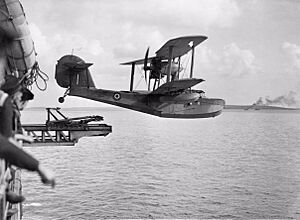HMS Bermuda (52) facts for kids

Bermuda in 1942
|
|
Quick facts for kids History |
|
|---|---|
| Name | Bermuda |
| Namesake | Bermuda |
| Builder | John Brown & Company, Clydebank |
| Yard number | 568 |
| Laid down | 30 November 1939 |
| Launched | 11 September 1941 |
| Commissioned | 21 August 1942 |
| Decommissioned | 1962 |
| Identification | Pennant number 52 |
| Fate | Scrapped, 26 August 1965 |
| General characteristics (as built) | |
| Class and type | Fiji-class light cruiser |
| Displacement | 8,631 long tons (8,770 t) (standard) |
| Length | 555 ft 6 in (169.3 m) |
| Beam | 62 ft (18.9 m) |
| Draught | 19 ft 10 in (6 m) |
| Installed power |
|
| Propulsion | 4 shafts; 4 geared steam turbine sets |
| Speed | 32.25 knots (59.73 km/h; 37.11 mph) |
| Range | 6,250 nmi (11,580 km; 7,190 mi) at 13 knots (24 km/h; 15 mph) |
| Complement | 733 (peacetime), 900 (wartime) |
| Armament |
|
| Armour |
|
| Aircraft carried | 2 × seaplanes |
| Aviation facilities | 1 × catapult, 2 × hangars |
HMS Bermuda was a powerful light cruiser ship of the Royal Navy. She was built during World War II and played an important part in the war. This ship was named after the British island of Bermuda. She was the eighth ship to carry this name.
Bermuda was built by a company called John Brown & Company in Clydebank. She was launched into the water on September 11, 1941. Sadly, the first ship of her type, Fiji, was sunk that same year. This happened during the evacuation of Crete.
Contents
Bermudas War Service
In 1942, Bermuda joined the North Africa campaign. She was part of the 10th Cruiser Squadron. This included Operation Torch, a big landing operation.
Bermuda and another cruiser, Sheffield, attacked a small fort. They faced attacks from Italian torpedo planes. Bermuda also helped protect landings at Bougie. She managed to avoid damage from many air attacks.
Later, Bermuda returned to the Atlantic Ocean. She helped escort ships in the Bay of Biscay. In June 1943, she carried people and supplies to Spitsbergen. She also hunted German U-boats (submarines) in the Atlantic.
After more time in the Arctic, she went to Glasgow in June 1944 for repairs. During these repairs, one of her main gun turrets was removed.
Journey to the Pacific
In May 1945, as the war in Europe was ending, Bermuda was sent to the Pacific Ocean. She arrived in Fremantle on July 1 to get fuel and supplies. Then, she sailed to Sydney, arriving on July 7.
In Sydney, she practiced with other Royal Navy ships. This included the battleship Anson. While there, they heard about the atomic bombings of Hiroshima and Nagasaki. This led to the surrender of Japan.
Bermuda then sailed to the Philippines, arriving on August 23. She became part of a mission to rescue Allied prisoners of war. These prisoners were held in areas previously controlled by Japan.
On September 6, Bermuda was attacked by Japanese planes. It seemed the pilots didn't know the war was over. Bermuda fought off the attack and continued her mission. She then took Allied prisoners of war to Shanghai to go home.
Bermudas Post-War Service

Bermuda stayed in the Far East as the main ship of the 5th Cruiser Squadron. In 1947, she returned to the UK for more repairs at Chatham Dockyard. After this, she was put into reserve, meaning she was not actively used.
In 1950, Bermuda was brought back into service. She became the flagship (main ship) for the Commander in Chief of the South Atlantic Station. She served there until 1953.
Helping Others
In 1953, Bermuda and her sister Gambia helped the Greek island of Zakynthos. The island was hit by a big earthquake, the Ionian earthquake. Greek officials were very thankful. They said the Royal Navy always helps first, which is their tradition.
In 1956, Bermuda was taken out of service again. She was towed to Palmer's at Hebburn on Tyne for a long period of repairs and upgrades. She got a new enclosed bridge and better gun controls.
After her upgrades, she returned to service. She spent the next few years doing exercises with other NATO navies. In April 1958, she went to Cyprus to help during civil unrest. Bermuda also attended the Ceremony of independence of Nigeria on October 1, 1960.
Bermuda was officially taken out of service in 1962. She had served for 21 years. She was then taken apart for scrap metal starting on August 26, 1965. Her ship's bell is now in the Royal Naval Association Club in West Bromwich. This British town had adopted Bermuda in 1942.
Connections to Bermuda
HMS Bermuda visited her namesake island several times. The people of Bermuda gave her many silver gifts. These included a large bell, which was sometimes used for baptisms of crew members' children. She also received four bugles. Two of these bugles are now with the Bermuda Regiment.
Most of the other gifts went missing after the ship was taken out of service. However, the bell and the bugles were saved. They are now kept at the Bermuda Maritime Museum. This museum is located at the former Bermuda Dockyard.


